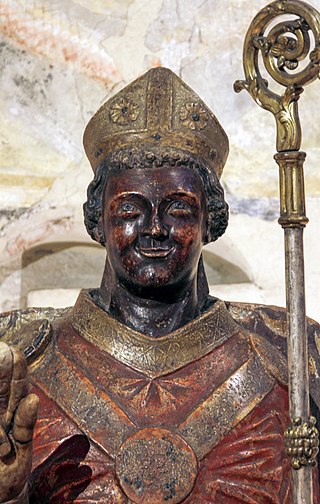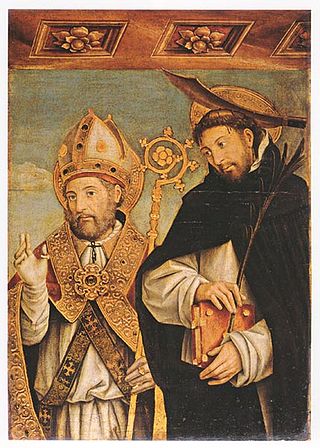
Saint Valentine was a 3rd-century Roman saint, commemorated in Western Christianity on February 14 and in Eastern Orthodoxy on July 6. From the High Middle Ages, his feast day has been associated with a tradition of courtly love. He is also a patron saint of Terni, epilepsy and beekeepers. Saint Valentine was a clergyman – either a priest or a bishop – in the Roman Empire who ministered to persecuted Christians. He was martyred and his body buried on the Via Flaminia on February 14, which has been observed as the Feast of Saint Valentine since at least the eighth century.

Vittorio Veneto is a city and comune situated in the Province of Treviso, in the region of Veneto, Italy, in the northeast of Italy, between the Piave and the Livenza rivers, borders with the following municipalities:

Zeno of Verona was an Afro-Italian Christian figure believed to have either served as Bishop of Verona or died as a martyr. He is venerated as a saint in the Catholic Church and the Orthodox Church.

Saint Renatus is the name of a French and an Italian saint of the Catholic Church who is claimed to be the same person. There are different stories of two saints with by the name Renatus, who were later merged into a single one based on their described similarities and contemporaneity. Both are venerated in Italy and France. They were: Saint Renatus of Sorrento, and Saint Renatus of Angers. Part of their stories seem to be a legend, part incomplete and part deficient historically documented.

Oderzo is a comune, with a population of 20,003, in the province of Treviso, in the Italian region of Veneto. It lies in the heart of the Venetian plain, about 66 kilometres to the northeast of Venice. Oderzo is crossed by the Monticano river, a tributary of the Livenza.

Eraclea is a small city and comune in the Metropolitan City of Venice, Veneto, northern Italy. It is located on the Adriatic coast between the towns of Caorle and Jesolo.

Saint Domninus of Fidenza is an Italian Catholic saint. According to tradition, he died in 304 AD and was a native of Parma. The cathedral in Fidenza is dedicated to him. The Hieronymian Martyrology commemorates Domninus, but does not include any further information about him, and his feast day is cited as occurring on 9 October. He is not commemorated in the martyrologies of Bede, Ado, Notker, or the Parvum Romanum.

Prosper of Reggio is an Italian saint. Tradition holds that he was a bishop of Reggio Emilia for twenty-two years. Little is known of his life, but documents attest that he was indeed bishop of Reggio Emilia in the fifth century.

Saint Gaugericus, in French Saint Géry was a bishop of Cambrai, France.

Evasius is believed to have been a missionary and bishop of Asti, in north-west Italy. He was forced to flee to the great Padan forest known as the Selva Cornea, where he and numerous followers were beheaded by pagan, or alternatively by Arian enemies, in the area of what is now Casale Monferrato. He is venerated as a saint of the Roman Catholic Church and is the patron of a number of towns in Piedmont and Lombardy. His cult is liveliest at Casale, where his remains are conserved in the cathedral dedicated to him.

Saint Justin of Chieti is venerated as an early bishop of Chieti, Italy. His date of death varies, and is sometimes given as the 3rd, 4th, or 6th centuries.
Saint Vitalian(us) of Capua was a 7th-century bishop of that city.

The Diocese of Vittorio Veneto is a Latin diocese of the Catholic Church in northern Italy, with its see in Vittorio Veneto. It was historically known as Diocese of Ceneda, the name being changed in 1939.

The da Camino were an Italian noble family whose fame is connected to the mediaeval history of the March of Treviso, a city of which they were lords for a while.

Chiaffredo is venerated as the patron saint of Saluzzo, Italy. Tradition considers him a member of the Theban Legion, but instead of being martyred with this legion at Agaunum, he escaped to Piedmont and was martyred there.

Eleutherius, also written as Eleutherus, Eleuterus and Eleftherios; sometimes called Liberalis or Liberator Greek: Ἐλευθέριος) and his mother Antia, or Anthia are venerated as Christian saints and martyrs in Greece and Italy.

Saint Nonnosus, also Nonosius, was a prior at the San Silvestre monastery on Monte Soratte north of Rome and later a monk at Suppentonia, near Civita Castellana. He was a contemporary of Saint Benedict of Nursia. Alban Butler has written that “so little information has survived about Nonnosus that he is not especially interesting in himself.” His name does not appear in any ancient martyrology.

Saint Magnus of Anagni, also known as Magnus of Trani or Magnus of Fabrateria Vetus, is venerated as the patron saint of Anagni.
Saint Titian of Brescia was a fifth-century bishop of Brescia. In the list of bishops of Brescia, he is considered the fifteenth bishop of Brescia, succeeding Vigilius and preceding Paul II. His episcopate is believed to have occurred at the end of the fifth century.
Saint Constantius of Aquino was a bishop of Aquino in Italy, noted for his gift of prophecy, and a saint. He is commemorated in the Roman Martyrology on Sept. 1.
















